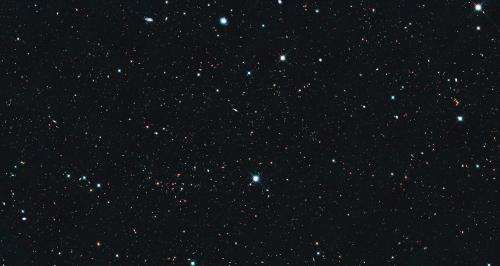Galaxies the way they were

(Phys.org) —Galaxies today come very roughly in two types: reddish, elliptically shaped collections of older stars, and bluer, spiral shaped objects dominated by young stars. The conventional wisdom is that the two types are related to one another, ellipticals representing an older, more evolved stage of galaxies. Astronomers have discovered during the past decade that these two categories seem also to apply to galaxies in the early universe. In particular, galaxies so distant from us that their light has been traveling for about eleven and one-half billion years, 84% of the age of the universe, also generally fall into these two groups.
A major puzzle about these early galaxy types involves their specific properties: Red elliptical galaxies today are generally large in diameter, but in the distant cosmos the corresponding galaxies are much smaller - perhaps five times smaller than local ones of the same mass and much smaller than their blue, star-forming colleagues. If galaxies gain in mass with time, through collisions or other processes, they would be expected also to increase in size with time. Therefore, if the early red galaxies really do represent older stages of bluer objects, then as a class they should be more massive and larger, not smaller.
The CANDELS project (Cosmic Assembly Near-Infrared Deep Extragalactic Legacy Survey) has acquired a very large database of optical and infrared observations of distant galaxies. Writing in one of their new papers this month, CfA astronomer Matt Ashby and the CANDELS team propose a solution to the dilemma. They studied a set of galaxies whose light has been en route for between about nine and twelve billion years. Based on the measured rates of star formation in blue galaxies inferred from the radiation, they conclude that they have undergone collisions that induce star formation. That's what makes them shine exceptionally brightly. After a billion years or so, however, these starbursts leave many of them depleted in fuel, and as a result the galaxies shrink in size to become the compact red galaxies that are so puzzling. In the later universe star-forming galaxies have grown to considerably larger sizes, and their star formation is consequently spread across much larger volumes, so that the same quenching mechanism does not take place, leaving them to retain their sizes as ellipticals.
Provided by Harvard-Smithsonian Center for Astrophysics





















